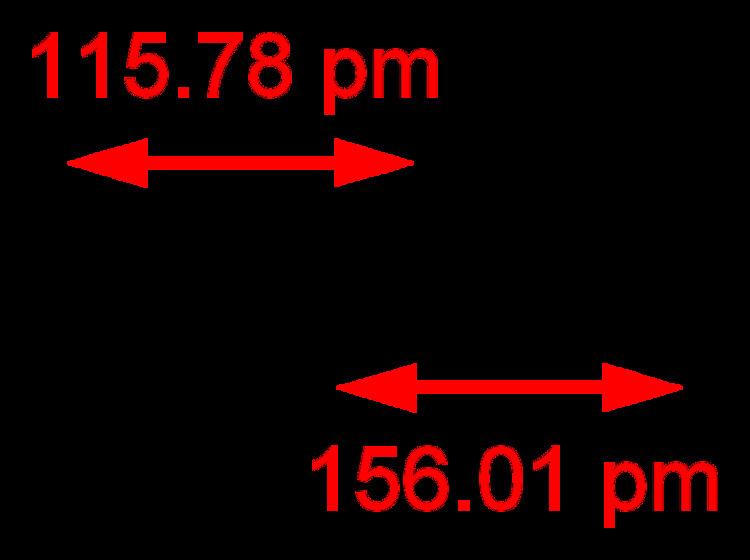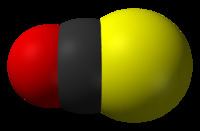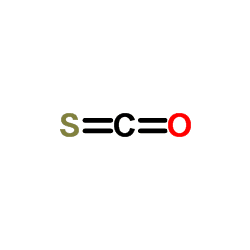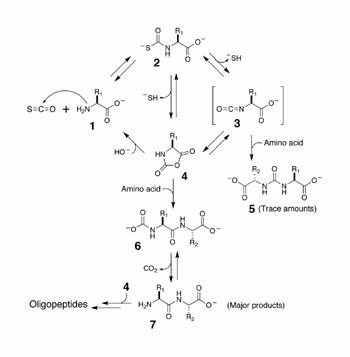Formula COS Density 2.51 g/cm³ | Molar mass 60.07 g/mol | |
 | ||
Related compounds | ||
Carbonyl sulfide
Carbonyl sulfide is the organic compound with the formula OCS. Commonly written as COS, it is a colourless flammable gas with an unpleasant odor. It is a linear molecule consisting of a carbonyl group double bonded to a sulfur atom. Carbonyl sulfide can be considered to be intermediate between carbon dioxide and carbon disulfide, both of which are valence isoelectronic with it.
Contents
- Carbonyl sulfide
- Krf2 lewis structure how to draw the lewis structure for krf2 krypton difluoride
- Occurrence
- Applications
- Synthesis
- Toxicity
- References

Carbonyl sulfide decomposes in the presence of humidity and bases to carbon dioxide and hydrogen sulfide.
This compound is found to catalyze the formation of peptides from amino acids. This finding is an extension of the Miller–Urey experiment and it is suggested that carbonyl sulfide played a significant role in the origin of life.

Krf2 lewis structure how to draw the lewis structure for krf2 krypton difluoride
Occurrence

Carbonyl sulfide is the most abundant sulfur compound naturally present in the atmosphere, at 6990500000000000000♠0.5±0.05 ppb, because it is emitted from oceans, volcanoes and deep sea vents. As such, it is a significant compound in the global sulfur cycle. Measurements on the Antarctica ice cores and from air trapped in snow above glaciers (firn air) have provided a detailed picture of OCS concentrations from 1640 to the present day and allow an understanding of the relative importance of anthropogenic and non-anthropogenic sources of this gas to the atmosphere. Some carbonyl sulfide that is transported into the stratospheric sulfate layer is oxidized to sulfuric acid. Sulfuric acid forms particulate which affects energy balance due to light scattering. The long atmospheric lifetime of COS makes it the major source of stratospheric sulfate, though sulfur dioxide from volcanic activity can be significant too. Carbonyl sulfide is also removed from the atmosphere by terrestrial vegetation by enzymes associated with the uptake of carbon dioxide during photosynthesis, and by hydrolysis in ocean waters. Loss processes, such as these, limit the persistence (or lifetime) of a molecule of COS in the atmosphere to a few years.

The largest man-made sources of carbonyl sulfide release include its primary use as a chemical intermediate and as a byproduct of carbon disulfide production; however, it is also released from automobiles and its tire wear., coal-fired power plants, biomass combustion, fish processing, combustion of refuse and plastics, petroleum manufacture, and manufacture of synthetic fibers, starch, and rubber. The average total worldwide release of carbonyl sulfide to the atmosphere has been estimated at about 3 million tons/year, of which less than one third was related to human activity. It is also a significant sulfur-containing impurity in synthesis gas.

Carbonyl sulfide is present in foodstuffs, such as cheese and prepared vegetables of the cabbage family. Traces of COS are naturally present in grains and seeds in the range of 0.05–0.1 mg·kg−1.

Carbonyl sulfide has been observed in the interstellar medium (see also List of molecules in interstellar space), in comet 67P and in the atmosphere of Venus, where, because of the difficulty of producing COS inorganically, it is considered a possible indicator of life.
Applications

Carbonyl sulfide is used as an intermediate in the production of thiocarbamate herbicides. Carbonyl sulfide is a potential alternative fumigant to methyl bromide and phosphine. In some cases, however, residues on the grain result in flavours that are unacceptable to consumers, e.g. barley used for brewing. Carbonyl sulfide is readily converted to the gaseous signaling molecule hydrogen sulfide by carbonic anhydrase enzymes in plants and mammals. Because of this chemistry, the release of carbonyl sulfide from small organic molecules has been identified as a strategy for delivering hydrogen sulfide in different biological contexts.
Synthesis

Carbonyl sulfide was first described in 1841, but was apparently mischaracterized as a mixture of carbon dioxide and hydrogen sulfide. Carl von Than first characterized the substance in 1867. It forms when carbon monoxide reacts with molten sulfur. This reaction reverses above 1200 K (930 °C; 1700 °F). A laboratory synthesis entails the reaction potassium thiocyanate and sulfuric acid. The resulting gas contains significant amounts of byproducts and requires purification.
KSCN + 2 H2SO
4 + H
2O → KHSO
4 + NH
4HSO
4 + COS
Toxicity
As of 1994, limited information existed on the acute toxicity of carbonyl sulfide in humans and in animals. High concentrations (>1000 ppm) can cause sudden collapse, convulsions, and death from respiratory paralysis. Occasional fatalities have been reported, practically without local irritation or olfactory warning. In tests with rats, 50% animals died when exposed to 6997140000000000000♠1400 ppm of COS for 90 minutes, or at 6997300000000000000♠3000 ppm for 9 minutes. Limited studies with laboratory animal studies also suggest that continued inhalation of low concentrations (~50 ppm for up to 12 weeks) does not affect the lungs or the heart.
